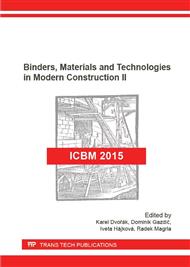[1]
KAFKA, Z.; PUNCOCHAROVA, J.: Vyuziti procesu solidifikace/stabilizace pri zneskodnovani nebezpecnych slozek v prumyslovych odpadech. In 12th Regional central European conference IUAPPA and 4th International conference on environmental impact assessment. 2000. VSCHT, Praha.
Google Scholar
[2]
BEDNARIK, V.; VONDRUKA, M.: Stabilizace/solidifikace nebezpecnych odpadu pomoci popilku z fluidniho spalovani. Univerzita Tomse Bati ve Zline: Fakulta technologicka. (2002).
Google Scholar
[3]
SPENCE, R. D.; SHI, C.: Stabilization and solidification of hazardous, radioative and mixed waste. Boca Raton, FL 33431: CRC PRESS, 2005. 356 s. 1-56670-444-8.
DOI: 10.1016/j.jhazmat.2005.04.033
Google Scholar
[4]
MALVIYA, R.; CHAUDHARY, R.: Factors affecting hazardous waste solidification/stabilization: A review, Journal of Hazardous Materials 137. 2006, pp.267-276.
DOI: 10.1016/j.jhazmat.2006.01.065
Google Scholar
[5]
EPA – Office of Solid Waste and Emergency Response, Solidification/Stabilization Use at Superfund Sites, 2000, United States, c. n. 68-W-99-003.
Google Scholar
[6]
X.D. Li, C.S. Poon, H. Sun, I.M.C. Lo, D.W. Kirk Heavy metal speciation and leaching behaviours in cement based solidified/stabilized waste materials, Journal of Hazardous Materials A 82; (2001), p.215–230.
DOI: 10.1016/s0304-3894(00)00360-5
Google Scholar
[7]
JAVŮRKOVÁ, D., Možnosti zneškodňování odpadů s obsahem těžkých kovů, 7. Odborná konference doktorského studia JUNIORSTAV 2005, Vysoké učení technické v Brně, Brno, (2005).
Google Scholar
[8]
MALVIZA, R., CHAUDHARY, R., 2006. Factors affecting hazardous waste solidification/stabilization: A review, J. Hazard. Mater. 137 (2006), p.267–276.
DOI: 10.1016/j.jhazmat.2006.01.065
Google Scholar
[9]
SPENCE, R. D., 2000. Book-Chemistry and microstructure of solidified waste forms, ISBN: 0873717481, p.288.
Google Scholar
[10]
Asavapisit S, Naksrichum S, Harnwajanawong N. Strength, leachability and microstructure characteristics of cement-based solidified plating sludge, In: Scrivener K, editors. Cement and Concrete Research 35, Lausanne; 2005, pp.1042-1049.
DOI: 10.1016/j.cemconres.2004.07.041
Google Scholar
[11]
Antemir A. Performance Assessment of Stabilised/Solidified Waste-Forms. University of Greenwich: Environmetal Science. Degree of Doctor of Philosophy; (2010).
Google Scholar


